This was published 7 years ago
Lithuania, Latvia and Estonia: Countries that are easy to cycle in Europe
By Andrew Bain
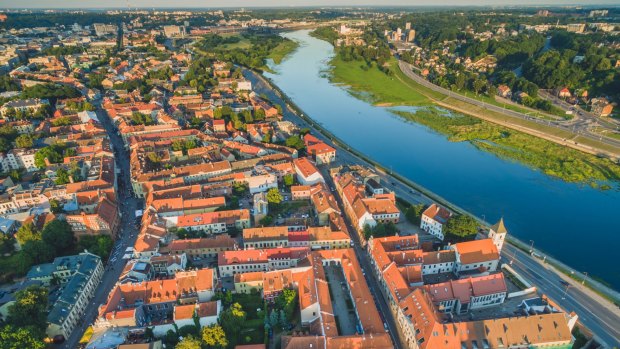
Kaunas city, Lithuania.Credit: iStock
Romas looks grave. "Tomorrow will be hilly," the cycling guide warns, foreshadowing a day of gruelling climbs on our bikes. As he talks, however, it becomes clear that these will be Baltic climbs – barely perceptible.
Over the coming nine days there will scarcely be a single climb of note as we pedal across Lithuania, Latvia and Estonia, a trio of countries laid out as flat as beach towels beside the Baltic. There could be few easier places in Europe to cycle.
Our journey begins outside of Vilnius, Lithuania's capital city, in the town of Trakai, where a 14th-century castle sprawls across an island in the middle of one of the 200 lakes that all but cover the region.
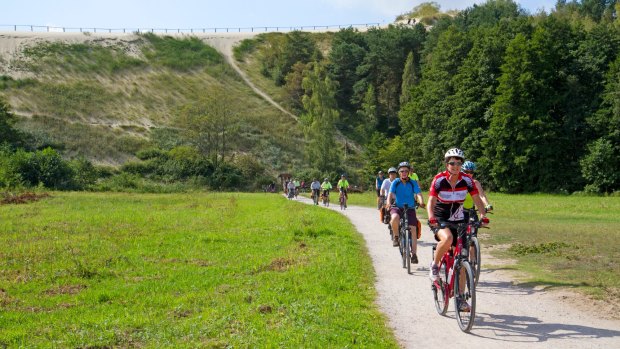
Cycling at the foot of Parnidis Dune.Credit: Andrew Bain
These lakes will be our companions throughout this day as we pedal west towards the Baltic coast. A storm boils in the distance but never finds us, and the pine forest is dotted with apple trees. For us, they are like vending machines from nature.
Around me is an eclectic bunch of cyclists, from seven members of an over-55 cycling club in Perth, to a Californian woman who, when asked about her cycling experience, claims she has none. "Well, I own a bike. I've probably ridden it 10 times."
There's a German man in his 70s who cycles in jeans and a woollen vest, and while there's the usual quota of Lycra and luminescence, Romas and fellow guide Ivars pedal in wetsuit booties and a pair of Birkenstocks, respectively. A Tour de France peloton we are not.
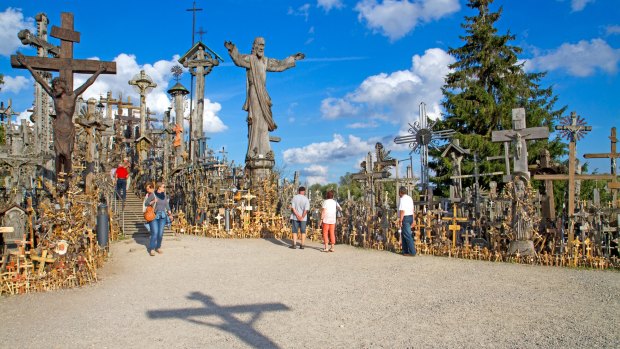
Hill of Crosses.Credit: Andrew Bain
This first day of riding is short – a mere stretching of the legs – as many of them will be. We'll cycle just 25 to 50 kilometres each day before being shuttled by bus to our nightly stops as we move incrementally north towards Tallinn. It's Baltic highlights on two wheels, beginning with the Baltic Sea coast, where we arrive the next morning on the shores of the Curonian Lagoon.
The lagoon is one of the Baltic coast's most striking natural features: a 1600-square-kilometre pool of water separated from the sea by the string-thin, 100-kilometre-long Curonian Spit. For two days we'll ride along the lagoon's shores, following Lithuania's sole signposted cycleway: the 200-kilometre Seaside Cycle Route.
We begin at the tip of a southern cape named Vente, home to a small 1863 lighthouse and one of the world's oldest bird observatories. Fierce gusts roar off the lagoon, stirring its shallow waters into the colour of milky coffee, and pushing at our backs, propelling us north on the quiet roads that make up this section of the Seaside Cycle Route.
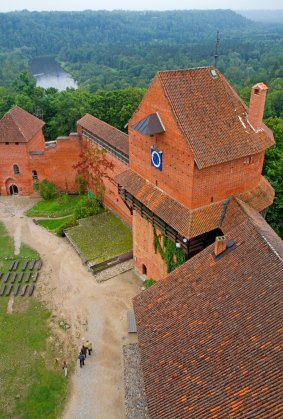
View over the Gauja Valley from Turaida Castle.Credit: Andrew Bain
Beside the roads, stork nests balance atop disused power poles in a truly Lithuanian scene. The country is said to have the world's highest concentration of storks, with about 21,000 nests.
The Seaside Cycle Route wraps around the Curonian Lagoon, running along the mainland coast but also along the spit, where we head the next morning, ferrying across from the Lithuanian port of Klaipeda.
The ferry docks at Nida, a small town about halfway along the spit, and briefly we ride south, parking our bikes at the base of the 70-metre-high Parnidis Dune, which takes its name from the fact that the shifting dune has twice devoured Nida, forcing the town to relocate.
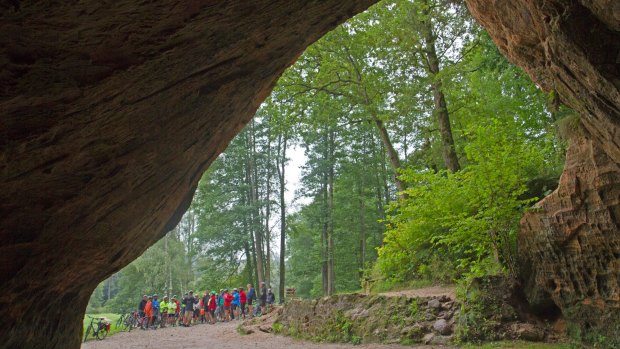
Cycling group at Latvia's Gutmanis Cave, the largest cave in the Baltics.Credit: Andrew Bain
From atop the dune the view reveals the fragility of the spit, both physically and politically. No more than a line of sand dunes in the sea, less than four kilometres across at its widest point, the spit is divided in half between Lithuania and the Russian enclave of Kaliningrad. The border is just a few metres south of Parnidis Dune, and the view from the dune includes a Russian military watchtower.
From here we will ride north, almost to the very tip of the spit, on dedicated bike paths that are as gently beautiful as any path in the world. Thick forest cloaks the spit's interior, while the coast looks at times like a golf links course, and at other times is nothing more than bare strips of sand.
We will stop at the Nida museum with the largest piece of amber in the Baltics (3.8 kilograms) and at the thatch-roofed house where Thomas Mann spent three summers admiring a view he likened to southern Italy.
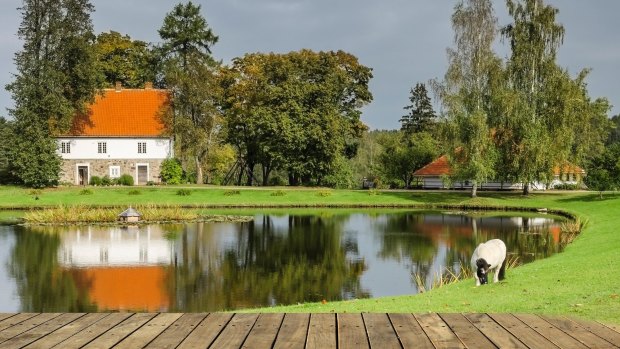
Rural landscape at the National Nature Reserve "Gauja", Latvia.Credit: iStock
For a time the trail runs hard against the spit's raw west coast, where the power of nature is stark. The sound of the Baltic Sea roars over the dunes, and even the pine trees, normally so reliably straight, are contorted by wind.
Through the small Baltics countries, the transitions are quick, and two days later we are pedalling in Latvia, Lithuania's northern neighbour, where once again the warnings are ominous.
"Brace yourself," Romas says, for this day we face the biggest climb of our entire week – a mere 80 metres.
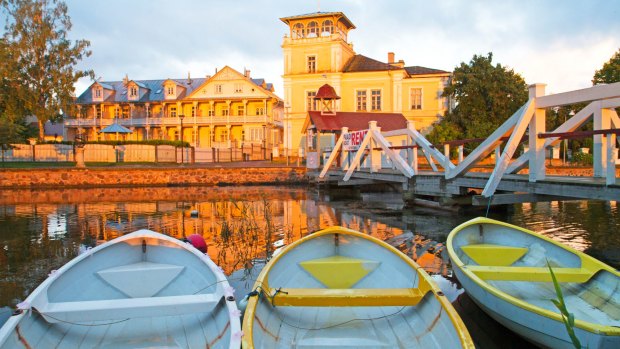
Dawn over the inlet at Haapsalu.Credit: Andrew Bain
We are riding out of Sigulda, the country's winter-sport capital, known locally as the Switzerland of Latvia. From here, a 1300-kilometre bike route known as LatEst circuits through Latvia and Estonia on a mix of sealed and gravel roads. This day, however, we're just tootling through the Gauja Valley, the centrepiece of what is arguably the most spectacular of Latvia's four national parks.
The valley this day is compressed by mist, giving it the eerie feel of an enchanted forest. It's beautiful, park-like cycling – autumnal forest on one side, grasslands and ponds on the other – that takes us past the largest cave in the Baltics, its walls covered in carvings-cum-graffiti that date back as far as 1667.
Sitting directly above Gutmanis Cave is sprawling Turaida Castle, said to be the most visited museum in Latvia. Like most great European castles it sits atop a hill – our journey's mini-Everest.
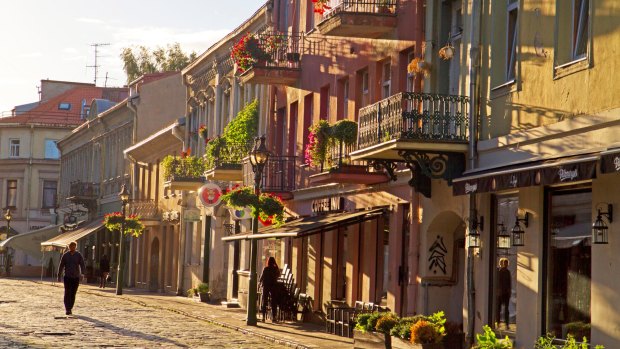
Dawn in the Lithuanian city of Kaunas.Credit: Andrew Bain
As the road steepens, the line of cyclists spreads. There are riders stepping off their bikes to push, and others almost inhaling the castle. And in just a few minutes, it's over.
The final piece of our tri-nations cycle is Estonia, the northernmost of the three Baltic countries. Here, our final days will be spent pedalling along coasts and around the second largest of Estonia's 1000-plus islands.
We arrive in the country on the bikes, pedalling across the border on a road beside the sea that barely deviates left or right, up or down. The change in everything but the landscape is stark. Turf-covered saunas sit in the gardens of homes that are painted the colour of berries or mustard, and blonde hair is suddenly the norm. It's Scandinavia with a formerly Soviet address.
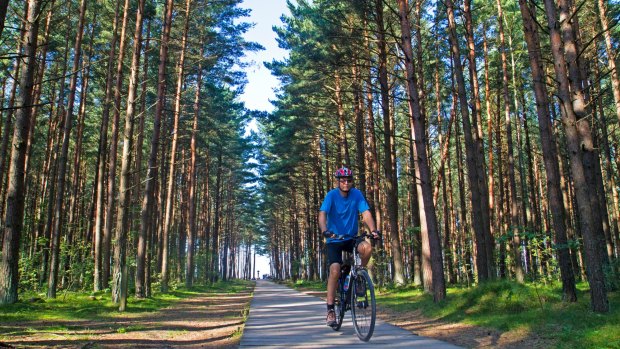
Cycling through pine forest on Lithuania's Seaside Cycle Route.Credit: Andrew Bain
The straight road north delivers us into Haapsalu, a gorgeous fishing town wrapped around an oversized castle and a protected inlet said to have inspired Tchaikovsky, who spent two summers here, to write Swan Lake. Sure enough this night, the inlet is covered in white swans.
Offshore from Haapsalu is Hiiumaa, the fourth-largest island in the Baltic Sea. The island is seemingly pegged into the water by lighthouses, which ring its shores. On our first day on the island, we will pedal from one lighthouse to another – Tahkuna Lighthouse to Ristna Lighthouse, both constructed by Gustave Eiffel's French factory.
At the island's northern tip, Tahkuna sits on a peninsula that was off-limits to civilians during Soviet times for its strategic position, guarding the entrance to the Gulf of Finland. Today it remains dotted with abandoned military bunkers, their rooms filled with rusted storage shelves for weapons.
In keeping with the ride, Hiiumaa is like a flat pontoon in the sea, making for effortless cycling. We turn off roads and follow ever-fainter wheel tracks deep into forests, where the earth is carpeted in blueberries. Riding past this bounty slows us more than any hill we've come across – soon all our lips and hands are stained blue.
As we near the end of our longest cycling day, we are confronted by the prospect of Kopu, the world's third-oldest lighthouse, built in 1531 atop one of Hiiumaa's few hills.
It's the final climb of our journey, a minute or two of pain. But who can be bothered when you have a belly full of blueberries and a dose of island lethargy? I hear people climbing off their bikes before the hill has barely begun.
FIVE OTHER BALTIC NATIONS ATTRACTIONS
HILL OF CROSSES (LITHUANIA)
A small hillock in Lithuania's flat north, covered in about 300,000 crosses, many of them originally placed here as protest against Soviet occupation. A sober and moving sight.
SAULKRASTI BICYCLE MUSEUM (LATVIA)
Get into the bike swing at this ode to the bike. Exhibits range from a pair of 1880s penny farthings, to Latvian-made bikes of the 1930s, when the country had more than 30 bicycle manufacturers.
RUNDALE PALACE (LATVIA)
Versailles in the Baltics at this 138-room,18th-century palace an hour's drive from the Latvian capital of Riga.
SAAREMAA (ESTONIA)
Estonia's largest island and its holiday playground, where you can journey among wooden windmills, castles and the ghosts of Soviet times, when the entire island was a closed military base.
PALANGA (LITHUANIA)
When in the Baltics, see the Baltic Sea at this cheerful resort town complete with grand palace and gardens.
TRIP NOTES
MORE INFORMATION
lithuania.travel; latvia.travel; visitestonia.com
GETTING THERE
Finnair flies daily to Vilnius (Lithuania) and Tallinn (Estonia) from Sydney and Melbourne. Flights connect through Singapore or Hong Kong as well as Helsinki. Phone 1300 132 944, see finnair.com
CYCLING THERE
UTracks runs an 11-day Treasures of the Baltic by Bike tour, beginning in Vilnius (Lithuania) and finishing in Tallinn (Estonia). Prices start from $2190. See utracks.com
Andrew Bain travelled courtesy of UTracks.
Sign up for the Traveller Deals newsletter
Get exclusive travel deals delivered straight to your inbox. Sign up now.